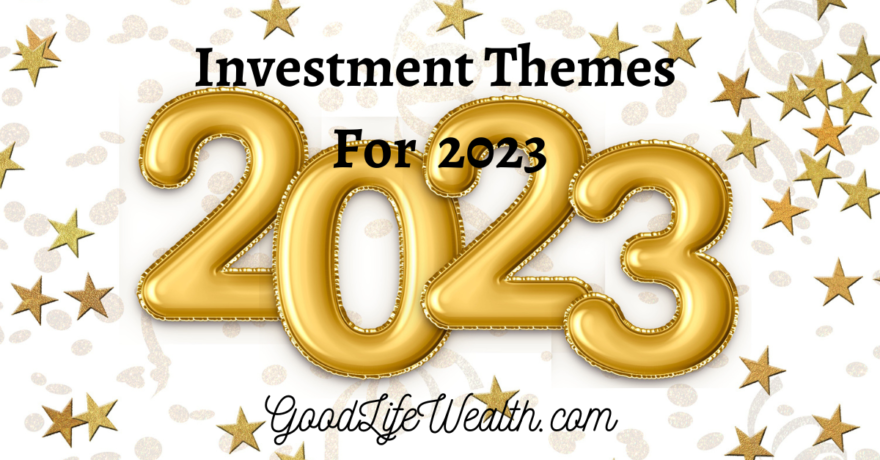Each year, I rethink our portfolio allocations and today I am sharing our Investment Themes for 2024. We don’t time the market, nor do we try to predict how the market will perform. I think this is not only impossible, but also likely to cause more harm than good. We remain globally diversified, use index funds, and maintain a buy and hold philosophy. We have a target asset allocation for each investor and rebalance positions when they drift from our targets.
But that doesn’t mean we are completely passive. No, each year we slightly adjust our portfolio models in two ways. First, we look at current valuations and expected long-term returns (typically 10 years). With this information we add weight to the Core categories which have better valuations and expected returns. And we reduce categories which might be overvalued and have lower expected returns. This is forward looking, rather than looking back at past performance.
The second adjustment we make to portfolios is to annually evaluate Alternative holdings for inclusion in our models. Alternative, or satellite, positions are smaller, more niche investments, which I don’t think merit permanent inclusion as a Core position, but may be appropriate at certain times. We will describe our alternative positions more below.
2023, Better Than Expected
2023 ended up being a great year in the stock market, with the S&P 500 up 24%. This was a shocker. A year ago, 85% of economists were predicting a recession in 2023. But it never happened and the consensus was wrong. A year ago, I wrote that in spite of the calls for recession, the bad news may have already been priced into stocks and that we would remain invested. You can read my Investment Themes for 2023 here. And here are links for my 2022 Themes and 2021 Themes.
Although the S&P 500 and NASDAQ had a great year in 2023, it was aften a frustrating year for investors. Market breadth was poor and performance was concentrated in a fairly small number of Growth and Technology stocks. 2/3 of stocks did worse than the S&P 500 average. And other categories, such as International, Small Cap, or Value, lagged the Mega-Cap names.
It was also a strange year for bond investors. Rising interest rates pushed down the prices of bonds, and detracted from their performance. So, unfortunately, bonds did not add much to the bottom line in 2023. But the flip side of rising rates is that we have purchased very attractive yields which we will hold and profit from for years to come.
Economic Expectations and Stocks
Markets had a great 2023 and the US avoided a recession. But I am afraid this is no guarantee that the economy is in the clear now. The Federal Reserve raised interest rates and has managed to bring inflation down to 3% without damaging the economy or causing higher unemployment – yet. In the past, such aggressive tightening by the Fed has led to a recession. Will they finally be able to engineer a “soft landing” and not cause a recession? The strength and resilience of the US economy in 2023 is truly the envy of the world.
Unfortunately, I think we need to remain cautious and recognize that it is possible that 2023 only postponed a slowdown rather than avoided one altogether. Today the consensus is that the Fed is done raising rates and will start cutting interest rates later in 2024 once inflation is closer to their 2% target. But none of this is a guarantee that a recession is off the table. 2024 could be another volatile year.
And where are we in terms of valuations? US stock earnings grew by 3% in 2023, but stock prices went up 24%. That means that now US stocks are even more overpriced and the expected returns going forward are lower. The returns of 2023 are surprising because they are unwarranted. US growth stocks have become more expensive, not better.
Looking at our core stock categories today, we have the same themes, but only more so. US Value is cheaper than Growth and has a higher expected return. International has a higher expected return than US. Small Cap is attractive relative to large cap. Emerging Markets have strong growth potential. We were already tilted towards Value and International at the start of the year, and this was early. US Growth outperformed in 2023, but the case for Value and International has only grown stronger and more compelling. Our outlook is for more than one year at a time, and sometimes that means we have to remain patient to see a reversion to the mean.
For 2024, we will make a small addition to our International funds, from our US Midcap funds. We use Index exchange traded funds (ETFs) for our Core positions.

Source: Vanguard Economic and Market Outlook for 2024, published December 2023
Interest Rates and Bonds
Interest rates rose steadily through October of 2023. We continued to buy individual Investment Grade bonds. Our core bond holdings are laddered from 1-5 years and we generally hold to maturity and reinvest. 2023 offered the best yields available in the past 15 years. We wanted to lock in some of these yields for longer, and so we had extended duration in 2023, adding some longer term 10-15 year bonds.
Interest rates peaked in October with the 10-year Treasury briefly touching 5%. Since then, the 10-year has fallen to 3.9%, a massive move in a very short period of time. (This high demand for bonds, and inverted yield curve, is a red flag for stocks and the economy.) We’ve seen a lot of Agency bonds getting called and refinanced to lower rates. And so it is possible we have seen the peak interest rates for this cycle already.
I am glad we were buying when we did and that we extended duration. Today, it is less attractive to buy longer bonds, and our purchases in 2024 will return to being on the shorter end of the yield curve. We will not be adding to bond holdings in 2024, just aiming to maintain our 1-5 year ladder as bonds mature or are called. But there is a good rationale for holding bonds. Real yields (after inflation) are attractive. We have purchased yields which are comparable to the expected 10-year return of US stocks. And so, the 60/40 portfolio at the start of 2024 looks better than it has in years. And if we have a Bear Market in stocks in the next couple of years, the bonds will be defensive and give us the opportunity to rebalance and buy stocks when (not if) they drop.
Alternatives
Bond yields have been so good in 2023 that the appeal of alternatives is less. Why take on a volatile, complex investment if T-Bills are yielding over 5%? We will not be adding to any alternative or satellite categories in our 2024 models. We have several existing positions, which we will continue to hold.
TIPS (Treasury Inflation Protected Securities) were added in 2022 and they have given us a good inflation hedge. Our largest TIPS holding will mature in 2027 and at this point the plan is to hold to maturity. Inflation is less of a concern now, but our TIPS are still paying a decent yield.
Last year, we trimmed our holdings in Preferred Stocks, which sold off as interest rates rose. Today, they have started to bounce back and offer yields over 6% while often trading at a 30% discount to their Par value. The current 6-8% cash dividends we receive from Preferreds is above the expected return of common stocks. I’m happy to have that cash flow for retirees or to have cash to reinvest throughout the year. There is some potential for price appreciation in the next rate cutting cycle, but I am happy to hold these for the dividends and ignore any price volatility.
Our third satellite holding is a small position in Emerging Markets bonds. We use a Vanguard fund and ETF, which offer low cost diversified access to this high yield sector. I’ve seen that this category often bounces back well after a difficult year. And after being down in 2022, our fund was up nearly 14% in 2023. The fund begins 2024 with a 7% yield.
Staying On Course
We look each year to make some minor changes in our allocations, and communicate these ideas in our “Themes” letter. But, I think the real key for investors is to think long-term and be willing and able to stick with the process. There will inevitably be ups and downs and the markets often surprise us and don’t do what we expect. We have done well to stick to the basics: Don’t try to outsmart the market. Buy and Hold index funds. Keeps costs and taxes to a minimum.
If you have questions about our Investment Themes for 2024, please reach out. Even with these themes, we still have different investment models for our clients’ individual needs, risk tolerance, and time horizon. 2023 was a year full of surprises, and we will have to see what is in store for 2024!





